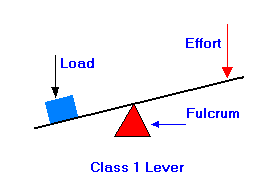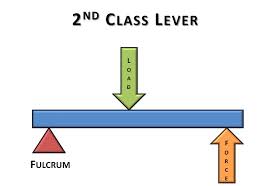Classes of Levers
When you think back to your elementary school days, you might remember learning about levers in science class. There are three classes of levers which effect effort and movement.
First class levers are uncommon in the human body. For example: extension, flexion. This is a depiction of a first class lever:

Second class levers allow you to have a mechanical advantage. For example, eccentric contraction of a bicep curl – elbow is the fulcrum, your bicep the load or resistance force and the weight is the force. All eccentric contractions are a second class lever.

Third class levers have a mechanical disadvantage. For example: concentric phase of a bicep curl – elbow is the fulcrum, bicep is the motive force, and the weight is the force. All concentric contractions are a third class lever.

Physical Laws Affecting Motion
There are three laws that affect motion. These three laws affect the way we work out and how efficient we are when we are moving.
- Law of inertia
- Law of acceleration and momentum
- Law of impact and Reactive Forces
1. Law of Inertia
A body at rest stays at rest, one in motion stays in motion using the same velocity and direction. Force is needed to start and decelerate movement. Therefore, when an exercise is being done, one can use force on the acceleration and deceleration of a motion.
2. Law of Acceleration and Momentum
Force=momentum x Acceleration (F=ma). The stronger you push the faster the acceleration becomes. Increase mass or velocity and momentum will also increase. For example a 20lbs weight has a greater momentum than a 10lbs weight. If one works to counter act the natural momentum of weights, then one is building muscle by using force.
3. Law of Impact and Reactive Forces
Every action has an equal and opposite reaction.
Applies to the force your body absorbs while doing exercises. Injuries from overuse and stress result from your body not being able handle impact and reaction force.




